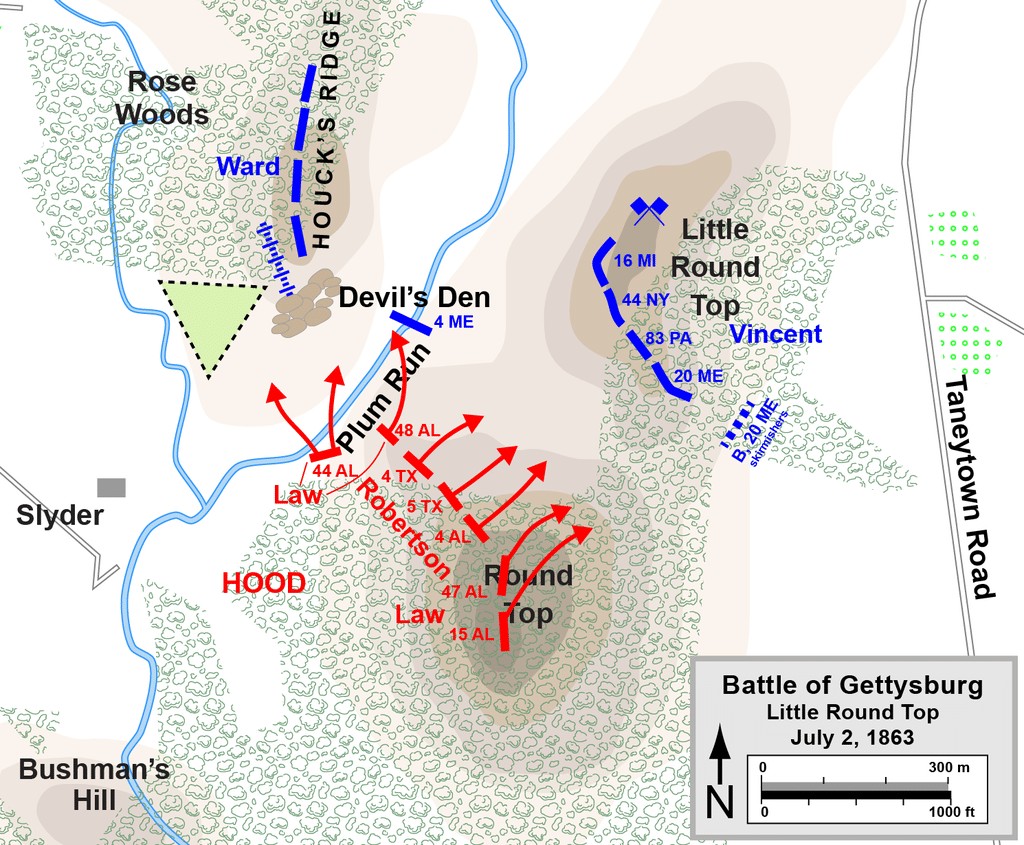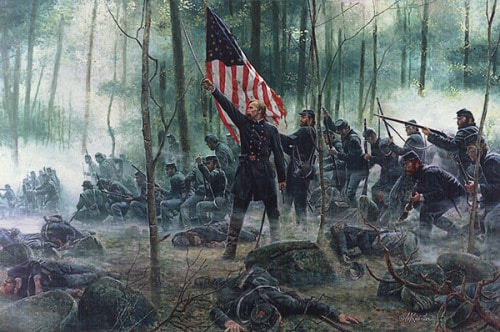At approximately 4 p.m. on July 2, 1863, the Confederates mounted a spirited attack on Little Round Top. Confederate Lt. General James Longstreet attacked the Union left on orders from General Robert E. Lee. The Confederate attack came up the Emmitsburg road, and the aim was to roll up the Union left flank.

As part of the coordinated attack, Confederate Brigadier General Evander Law's division under Major General John Bell Hood advanced toward Little Round Top on the extreme left flank of the Union army.
The hill had been left vacant when Union General Daniel Sickles III Corps disobeyed a direct order from Major General George G. Meade.
He advances his troops forward from his ordered position to take advantage of higher ground a half mile to the northwest, creating a salient in the Union line and leaving Little Round Top largely undefended.
When General George Meade was made aware of Sickle's position, he sent Brigadier General Gouverneur K. Warren, the chief engineer, to survey the situation.
Warren found Little Round Top deserted and, in the distance, claimed to see the glint of sun off Confederate bayonets and realized they were headed toward his position.
Warren sent dispatches to find troops in the area that could occupy the position. Major General George Sykes was found in the area, and he sent a dispatch of his own commanding 1st Division to occupy the hill.
On the way there, the dispatcher ran into Colonel Strong Vincent, and without reporting to his superior officer, Vincent ordered his brigade to defend the hill.
The four regiments, the 16th Michigan, 44th New York, 83rd Pennsylvania, and the 20th Maine, were positioned by Vincent with the Michigan regiment on the far right and the Maine regiment on the far left.
After positioning the 20th Maine, he explained to Colonel Joshua L. Chamberlain that he was to hold that position at all costs and that he could not withdraw. The 20th Maine represented the extreme left of the Union army, and they had less than 10 minutes to prepare for the inevitable assault from the Alabama brigade of Hood's division.
The 4th and 5th Texas regiments, also from Hood's division, drove up the slope, hitting the 16th Michigan head-on. Just as the Union center was faltering, the 140th New York Zouaves, led by Colonel Patrick O'Rorke, reinforced and saved the Union brigade from total collapse. Both Colonel Vincent and Colonel O'Rorke were mortally wounded while leading their troops. Vincent died 5 days later on July 7, and while on his deathbed, was promoted to brigadier general.

On the Union left, Colonel Chamberlain was told that the Confederates were reforming their lines to overlap those of the 20th Maine. Chamberlain stretched his lines thin and set them in a right-angle formation to counter. Hood had ordered the 15th and 47th Alabama, led by Colonel William C. Oates, to collapse and roll the Union left, but Chamberlain's adjustment held the line.
After 90 minutes of holding the Union left, the 20th Maine was running very low on ammunition. Chamberlain ordered his men to fix bayonets and planned a right-wheel maneuver down the hill to sweep the Alabama regiments off the hill. The successful charge led to the capture of many Confederates and effectively ended the assault on Little Round Top.
